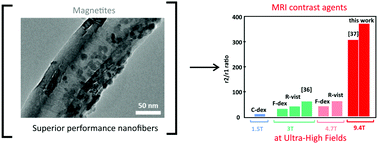Nanoscale engineering of hybrid magnetite–carbon nanofibre materials for magnetic resonance imaging contrast agents
Abstract
Magnetic nanomaterials show significant promise as contrast agents for magnetic resonance imaging (MRI). We have developed a new highly efficient one-step procedure for the synthesis of magnetically-functionalised hollow carbon nanofibres, where (i) the carbon nanofibres act as both a template and a support for the nucleation and growth of magnetite nanoparticles and (ii) the structural (size, dispersity and morphology) and functional (magnetisation and coercivity) properties of the magnetic nanoparticles formed on nanofibres are strictly controlled by the mass ratio of the magnetite precursor to the nanofibres and the solvent employed during synthesis. We have shown that our magnetite-nanofibre materials are effectively solubilised in water resulting in a stable suspension that has been employed as a “negative” MRI contrast agent with an excellent transverse relaxivity (r2) of (268 ± 13) mM s−1, surpassing current commercial materials and state-of-the-art magnetic nanoscale platforms in performance for MRI contrast at high magnetic fields. The preparation and evaluation of this unique hybrid nanomaterial represents a critical step towards the realisation of a highly efficient “smart” MRI theranostic agent – a material that allows for the combined diagnosis (with MRI), treatment (with magnetic targeting) and follow-up of a disease (with MRI) – currently in high demand for various clinical applications, including stratified nanomedicine.



 Please wait while we load your content...
Please wait while we load your content...